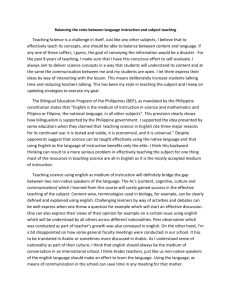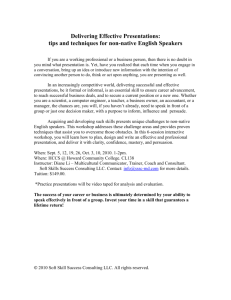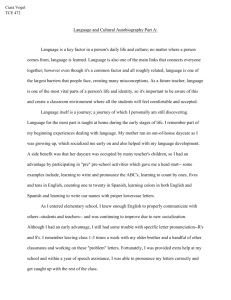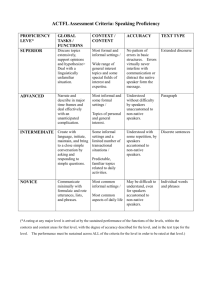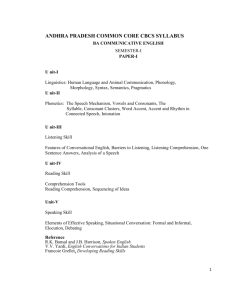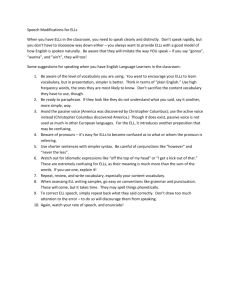Working with International Students in Class
advertisement
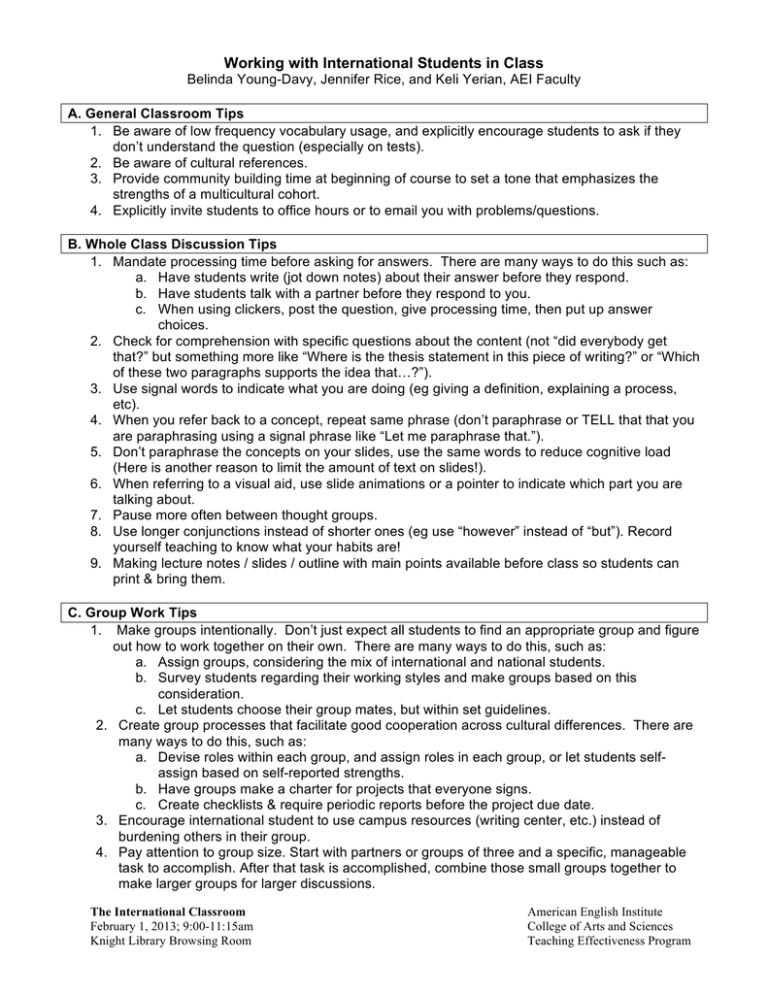
Working with International Students in Class Belinda Young-Davy, Jennifer Rice, and Keli Yerian, AEI Faculty A. General Classroom Tips 1. Be aware of low frequency vocabulary usage, and explicitly encourage students to ask if they don’t understand the question (especially on tests). 2. Be aware of cultural references. 3. Provide community building time at beginning of course to set a tone that emphasizes the strengths of a multicultural cohort. 4. Explicitly invite students to office hours or to email you with problems/questions. B. Whole Class Discussion Tips 1. Mandate processing time before asking for answers. There are many ways to do this such as: a. Have students write (jot down notes) about their answer before they respond. b. Have students talk with a partner before they respond to you. c. When using clickers, post the question, give processing time, then put up answer choices. 2. Check for comprehension with specific questions about the content (not “did everybody get that?” but something more like “Where is the thesis statement in this piece of writing?” or “Which of these two paragraphs supports the idea that…?”). 3. Use signal words to indicate what you are doing (eg giving a definition, explaining a process, etc). 4. When you refer back to a concept, repeat same phrase (don’t paraphrase or TELL that that you are paraphrasing using a signal phrase like “Let me paraphrase that.”). 5. Don’t paraphrase the concepts on your slides, use the same words to reduce cognitive load (Here is another reason to limit the amount of text on slides!). 6. When referring to a visual aid, use slide animations or a pointer to indicate which part you are talking about. 7. Pause more often between thought groups. 8. Use longer conjunctions instead of shorter ones (eg use “however” instead of “but”). Record yourself teaching to know what your habits are! 9. Making lecture notes / slides / outline with main points available before class so students can print & bring them. C. Group Work Tips 1. Make groups intentionally. Don’t just expect all students to find an appropriate group and figure out how to work together on their own. There are many ways to do this, such as: a. Assign groups, considering the mix of international and national students. b. Survey students regarding their working styles and make groups based on this consideration. c. Let students choose their group mates, but within set guidelines. 2. Create group processes that facilitate good cooperation across cultural differences. There are many ways to do this, such as: a. Devise roles within each group, and assign roles in each group, or let students selfassign based on self-reported strengths. b. Have groups make a charter for projects that everyone signs. c. Create checklists & require periodic reports before the project due date. 3. Encourage international student to use campus resources (writing center, etc.) instead of burdening others in their group. 4. Pay attention to group size. Start with partners or groups of three and a specific, manageable task to accomplish. After that task is accomplished, combine those small groups together to make larger groups for larger discussions. The International Classroom February 1, 2013; 9:00-11:15am Knight Library Browsing Room American English Institute College of Arts and Sciences Teaching Effectiveness Program English Language Learner FAQ Jennifer Rice and Jodi Weber, AEI Faculty 1. How do I help English Language Learner’s (ELLs) improve their grammar without focusing too much on it? Depending on the home language, are their specific areas of mechanics that would naturally come up that we should be aware of? (ex. tense for Chinese students.) - Emphasize the grammar errors that hinder comprehension. Verb tenses are key for all students. They have studied and learned all of them every which way. Sentence structure, complete sentences, clear subject and verb for each sentence are all critical. Mistakes in articles (a / an / the) and preposition choice are problems ELLs will have for the rest of their lives. Don’t stress over those unless it interferes with meaning. 2. What’s the best type of feedback for grammar, throughout the course? - First, do NOT simply correct all of their mistakes for them. You could just underline major grammatical errors and hold them accountable for finding and fixing the problems. Often they can identify the problem once it’s pointed out to them. Marginal comments or comments at the end of the page such as “check verb tenses” or “subject-verb agreement” or “singularplural” are quick and easy ways to highlight repeated errors, especially if the errors are underlined. 3. When I talked with my Chinese students about it, I get the feeling that Chinese writing has a proscribed method that is used for instruction, like the five-paragraph style (one of them tried to explain to me, but I didn't quite follow). If AEI has any information about other kinds of writing that any of our international students might have been asked to do in their country of origin, I'd love to know more about it. Some characteristics of non-Western writing styles: - Eight-legged Essay - Essays that circle and circle and circle - Main point often comes at the end (sometimes in the middle) - Author’s status is often important to establish - Building rapport is often more important than the point of the paper - Yes, this is a problem. Pointing out the cultural differences is important, as it is to stress that we tend to be very direct and up front with our writing. 4. When is it reasonable (if ever) to let them write in their native language? (ex. during brainstorming?) - I wouldn’t let them in any academic writing situation. It is so easy to revert to one’s native language, but they are doing themselves a disservice. They need the vocabulary and sentence structure in English. They need the practice in English. By writing or even brainstorming first in their native language, they then tend to translate and make everything fit into the native language form. They need to develop the ability to think in English. 5. How can I make formatting instructions clearer? - Show samples. Show an example of a well-formatted paper and a poorly formatted paper. What are your expectations? Make it clear that different instructors may have different preferences, but common to almost all is the standard double-spaced, one-inch margins, etc. 6. What’s the best response to students I think are pretending to understand me? The International Classroom February 1, 2013; 9:00-11:15am Knight Library Browsing Room American English Institute College of Arts and Sciences Teaching Effectiveness Program - Ask concrete questions that require an answer that shows they understand. Wishy-washy: “Any questions?” or “Did you get that?” or “Do you understand?” Concrete: “When is your assignment due?” or “How long should this paper be?” or “Please underline the thesis statement in this piece of writing.” 7. How can I make more time for ELLs and still be fair to the entire class? - Form groups that mix in the ELLs so that other students are helping them a bit. - Invite ELLs to your office hours- maybe even in groups??? - Ask them to use other on-campus facilities like the Writing Center - Utilize tech options (Bb “Journals”, Email, etc.) to communicate with ELLs outside of class 8. How can I talk to both non-ELL and ELLs about the best way to work with one another? - Take a portion of Class 1 to get into small groups and do a task together that involves asking about past writing experiences, hometowns, etc. - Set up an assignment that makes the native English speakers NEED to talk with the ELLs (interview of cultural difference that leads to a paper, etc.) - Talk up the cultural diversity as an asset to the class and formulate topics around that. 9. One of my students doesn’t know how to use the syllabus and keeps emailing me with questions about assignments. How can I help her read the syllabus? - In Week 1 of the course, have a quiz about key points of the syllabus on Bb. - Invite her to your office and explain it face-to-face. - Refer to it at the beginning of each week to show where you are in the course. - Make language simple on your syllabus and use lots of white space in the layout. 10. What’s the best way to approach the AEIS class recommendations? (One teacher had announced to the whole class that it wasn't recommended for non-native speakers to take WR 121 before AEIS 110 or 111. The next class, all non-native speakers were gone and she feared she'd scared them all off.) - Maybe they were right to be scared??? AEIS 110 or 111 is strongly recommended before taking WR 121, if students test into these classes. - Perhaps focus on the fact that you want them to be successful and that the best way to do that is to take their AEIS classes (110 & 111) before taking WR 121, if they are required to do so. 11. How do I handle gifts from ELL’s? - If it’s reasonable, smile and say thanks. Make it clear that their grade will not be affected by this gift. In some cultures, this is normal. We occasionally get gifts in the Intensive English Program in the AEI. - If it’s over the top, explain the cultural differences to him/her and don’t accept it. The International Classroom February 1, 2013; 9:00-11:15am Knight Library Browsing Room American English Institute College of Arts and Sciences Teaching Effectiveness Program Helping Non-Native Writers Belinda Young-Davy, Jennifer Rice, and Keli Yerian, AEI Faculty Adapted and taken from Eric S. Nelson’s “Quick tips for helping non-native writers,” Sheryl Holt’s “Responding to nonnative speakers of English,” and Kit Hansen’s “Working with non-native speakers.” All of these resources and more are available at http://writing.umn.edu/tww/responding/index.html It is important to remember that your idea of good writing may be fundamentally different from nonnative writers. For example, in some other cultures, directness and conciseness are not highly valued. Assignments/Giving Feedback • Interpreting handwritten comments can be very difficult for many non-native speakers. One student for example, could not interpret the handwritten word "location" because it looked like the numeral "10" followed by the non-word "cation." • Give assignment sheets that spell out what you expect: purpose of the assignment, length and format of the paper, use of sources, connection to course content, organization, evaluation, and so on. • Provide examples of successful papers, partial or complete. • If feasible, encourage students to turn in trial drafts (or even 1-2 draft paragraphs). A quick read of a trial draft can save you time later. • Put more direct, instructive and extensive comments on papers, for example, "You need to state the topic in the first paragraph” or “ This information is in the wrong” -- and should tell the student why. • Ask specific questions or provide specific comments to get at content, for example, “I thought you were saying x, but do you really mean y?” “Can you give me an example of x?” Organization/Style • Pay careful attention to the language of assignments. Sometimes simple words are less understandable to a non-native speaker than more "academic" words. Less likely to be clear More likely to be clear I want your take on the subject I want you to discuss the strengths and weaknesses of the author’s argument. What do you make of... How do you interpret... Sketch the development of ... Describe the development of ... In order to make it in politics... In order to succeed in politics... • In assignment sheets, use culture-neutral terms when possible, for example, "six-year-old child" instead of "first-grader"). When you, or a text, use culture-specific terms (for example, Rosa Parks or GOP), explain them or provide resources that explain. • Suggest that students signal their moves in writing overtly, and show examples of language that can help them do this: "I will examine the consequences of..." "What conclusion can we draw..." "An example of this is..." "I have tried to explain..." The International Classroom February 1, 2013; 9:00-11:15am Knight Library Browsing Room American English Institute College of Arts and Sciences Teaching Effectiveness Program Content vs. Grammar & Mechanics • Make sure students are familiar with whichever paper format you assign (e.g., APA, MLA, Chicago) • Focus on content first and ignore the grammar, so you can determine what else needs work. • Eventually, give specific feedback on both grammar and the organization. • Correct grammar for consistent problems, for example, if they always write “she” when they mean “he.” Provide a rule for the consistent problem and ask the student to correct THAT mistake throughout the paper. Correcting all of a student’s grammatical issues can be overwhelming to both teacher and student. • Consider Error Gravity. This is a linguistic theory that rates errors according to how they interfere with comprehension and the degree of irritation they cause the reader. Errors that affect comprehension need more attention than those that irritate. • Decide what is tolerable WRITING ACCENT—ideas are understandable though the paper still contains minor errors such as singular/plural agreement problems and article errors. • Temper feedback on common grammatical issues. Non-native writers are slow to (and may never fully) acquire certain aspects of English grammar such as: o Articles (a/the), Prepositional phrases (on a bus vs. in a car), Third-person singular (she eats, everybody know) Like other grammatical corrections point out the error when it interferes with comprehension, but don’t get bogged down or bog the student down with repetitive corrections. • Vocabulary - Students need to know terms for the content of the course ( e.g. analysis, synthesis, etc.). Technical terms may be confused. Expect to see flowery writing (especially adj. and adv. use), and awkward phrasing. • Idiomatic expressions and phrasal verbs are easily mixed up. What may seem intuitive to us, such as the difference between get and get up can be confusing for non-native writers. Additionally, idiomatic expressions are often “mislearned” (in the other hand vs. on the other hand). Make a correction, but also refer the student to a dictionary or explain the difference in meaning/error. The International Classroom February 1, 2013; 9:00-11:15am Knight Library Browsing Room American English Institute College of Arts and Sciences Teaching Effectiveness Program

